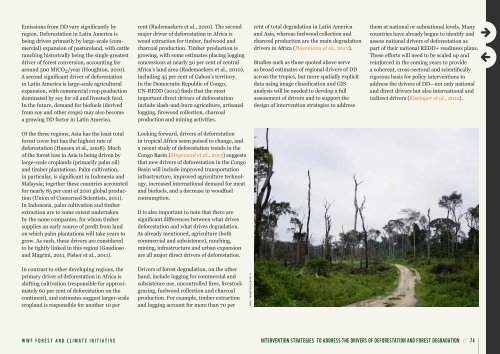WWF Guide to Building REDD+ Strategies
WWF Guide to Building REDD+ Strategies
WWF Guide to Building REDD+ Strategies
Create successful ePaper yourself
Turn your PDF publications into a flip-book with our unique Google optimized e-Paper software.
Emissions from DD vary significantly by<br />
region. Deforestation in Latin America is<br />
being driven primarily by large-scale (commercial)<br />
expansion of pastureland, with cattle<br />
ranching his<strong>to</strong>rically being the single greatest<br />
driver of forest conversion, accounting for<br />
around 500 MtCO2/year (Hough<strong>to</strong>n, 2010).<br />
A second significant driver of deforestation<br />
in Latin America is large-scale agricultural<br />
expansion, with commercial crop production<br />
dominated by soy for oil and lives<strong>to</strong>ck feed.<br />
In the future, demand for biofuels (derived<br />
from soy and other crops) may also become<br />
a growing DD fac<strong>to</strong>r in Latin America.<br />
Of the three regions, Asia has the least <strong>to</strong>tal<br />
forest cover but has the highest rate of<br />
deforestation (Hansen et al., 2008). Much<br />
of the forest loss in Asia is being driven by<br />
large-scale croplands (primarily palm oil)<br />
and timber plantations. Palm cultivation,<br />
in particular, is significant in Indonesia and<br />
Malaysia; <strong>to</strong>gether these countries accounted<br />
for nearly 85 per cent of 2010 global production<br />
(Union of Concerned Scientists, 2011).<br />
In Indonesia, palm cultivation and timber<br />
extraction are <strong>to</strong> some extent undertaken<br />
by the same companies, for whom timber<br />
supplies an early source of profit from land<br />
on which palm plantations will take years <strong>to</strong><br />
grow. As such, these drivers are considered<br />
<strong>to</strong> be tightly linked in this region (Gaudioso<br />
and Magrini, 2011, Fisher et al., 2011).<br />
In contrast <strong>to</strong> other developing regions, the<br />
primary driver of deforestation in Africa is<br />
shifting cultivation (responsible for approximately<br />
60 per cent of deforestation on the<br />
continent), and estimates suggest larger-scale<br />
cropland is responsible for another 10 per<br />
<strong>WWF</strong> FOREST AND CLIMATE INITIATIVE<br />
cent (Rademaekers et al., 2010). The second<br />
major driver of deforestation in Africa is<br />
wood extraction for timber, fuelwood and<br />
charcoal production. Timber production is<br />
growing, with some estimates placing logging<br />
concessions at nearly 30 per cent of central<br />
Africa’s land area (Rademaekers et al., 2010),<br />
including 45 per cent of Gabon’s terri<strong>to</strong>ry.<br />
In the Democratic Republic of Congo,<br />
UN-REDD (2012) finds that the most<br />
important direct drivers of deforestation<br />
include slash-and-burn agriculture, artisanal<br />
logging, firewood collection, charcoal<br />
production and mining activities.<br />
Looking forward, drivers of deforestation<br />
in tropical Africa seem poised <strong>to</strong> change, and<br />
a recent study of deforestation trends in the<br />
Congo Basin (Megevand et al., 2013) suggests<br />
that new drivers of deforestation in the Congo<br />
Basin will include improved transportation<br />
infrastructure, improved agriculture technology,<br />
increased international demand for meat<br />
and biofuels, and a decrease in woodfuel<br />
consumption.<br />
It is also important <strong>to</strong> note that there are<br />
significant differences between what drives<br />
deforestation and what drives degradation.<br />
As already mentioned, agriculture (both<br />
commercial and subsistence), ranching,<br />
mining, infrastructure and urban expansion<br />
are all major direct drivers of deforestation.<br />
Drivers of forest degradation, on the other<br />
hand, include logging for commercial and<br />
subsistence use, uncontrolled fires, lives<strong>to</strong>ck<br />
grazing, fuelwood collection and charcoal<br />
production. For example, timber extraction<br />
and logging account for more than 70 per<br />
© JULIE PUDLOWSKI / <strong>WWF</strong><br />
cent of <strong>to</strong>tal degradation in Latin America<br />
and Asia, whereas fuelwood collection and<br />
charcoal production are the main degradation<br />
drivers in Africa (Hosonuma et al., 2012).<br />
Studies such as those quoted above serve<br />
as broad estimates of regional drivers of DD<br />
across the tropics, but more spatially explicit<br />
data using image classification and GIS<br />
analysis will be needed <strong>to</strong> develop a full<br />
assessment of drivers and <strong>to</strong> support the<br />
design of intervention strategies <strong>to</strong> address<br />
them at national or subnational levels. Many<br />
countries have already begun <strong>to</strong> identify and<br />
assess national drivers of deforestation as<br />
part of their national <strong>REDD+</strong> readiness plans.<br />
These efforts will need <strong>to</strong> be scaled up and<br />
reinforced in the coming years <strong>to</strong> provide<br />
a coherent, cross-sec<strong>to</strong>ral and scientifically<br />
rigorous basis for policy interventions <strong>to</strong><br />
address the drivers of DD—not only national<br />
and direct drivers but also international and<br />
indirect drivers (Kissinger et al., 2012).<br />
inteRvention StRateGieS <strong>to</strong> addReSS tHe dRiveRS oF deFoReStation and FoReSt deGRadation // 74

















